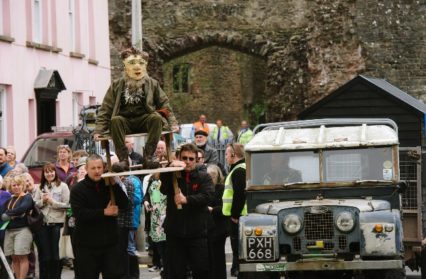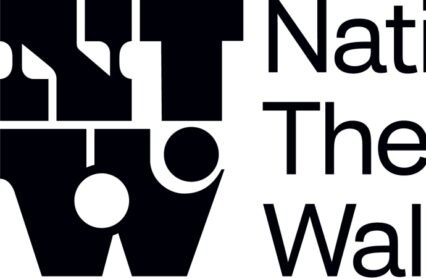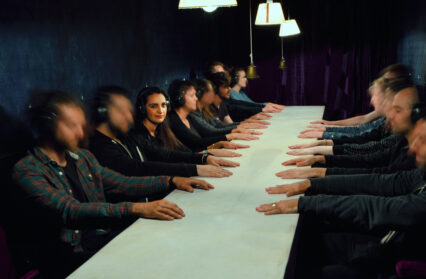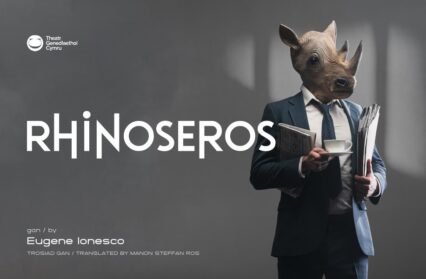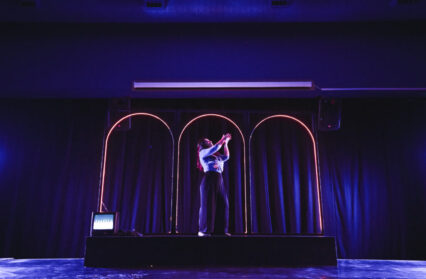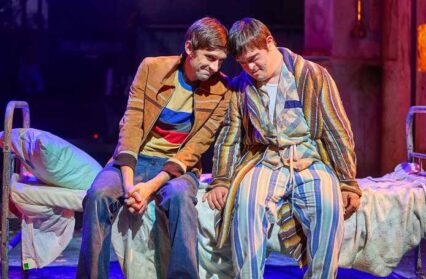Dylan Moore reviews Raw Material: Llareggub Revisited, Marc Rees’ next theatre installation with National Theatre Wales in Laugharne.
‘The town and its people are the real stars of the show’ is the line a reviewer could write before stepping off the bus in Laugharne. Site-specific theatre of the Marc Rees and Jon Tregenna kind has been the lifeblood of National Theatre Wales; promenade performances, community collaborations and ‘immersive experiences’ have been touchstones of the John McGrath era at NTW. But rarely has the experience been as loose as it is in Raw Material: Llareggub Revisited, a township-wide ‘happening’ that spreads theatre, installation and real life adventure over the best part of three absorbing hours.
Early critical complaints have centred on a perceived lack of characters and performances. I think a point, or perhaps several, have been missed. Firstly, Raw Material had a sister production: the BBC’s glossy who’s-who-of-Welsh-celebrity twenty-first century televisual makeover for the original ‘play for voices’. For contrast, Raw Material had to be really raw. Secondly, there is balance to strike in these kinds of productions. Between art and theatre, high concept and wide appeal, and – crucially – how much to corral the audience and how much to let them explore. On all counts, I think the balance was far closer to lovely than ugly.
Raw Material engendered the same strong sensory imprints on the memory as Marc Rees’ previous work with NTW, For Mountain, Sand and Sea. But in Barmouth I felt corralled; there were too many road cones, too many well-meaning orange-jacketed stewards telling you where to go and what to look at next. In Laugharne, armed with only a map – ‘The Thomas Centenary Tour: A Guided Trail Through Laugharne’ – I feel free. Afterward, I noted that the word ‘Guided’ had been struck through; a deliberate, crucial choice.
Once the scene has been set – with atmospheric archive footage of Dylan’s Laugharne, a voiceover that claims the poet as ‘a writer for the night’, ‘the private conscience of his time’ and an introductory talk by a randy bus driver – we are left to roam, down Mog Edwards’ Upstreet and up Myfanwy Price’s Downstreet. If we want to we can head up to the Boathouse, or if we feel like it we can visit the Grave.
Death courses through Raw Material in the same way it pulses through Under Milk Wood. As well as Dylan’s final resting place, you could visit The Pelican, a smart Georgian house opposite the Browns Hotel, where a coffin has been passed through the window in reenactment of the poet’s final journey. Later, we find ourselves as mourners on this same route; locals line Laugharne’s single major street to watch the bizarre spectacle of a black fish-and-chips selling shed being wheeled away to the melancholy sound of the Laugharne Players’ intense humming.
The Shed, of course, is the ultimate piece of symbolism. For all that Voyce’s Creations’ pop-up installations litter the town – eighteen are marked on the official map, along with the phrase ‘and many more!’ – the most iconic is Laugharne’s permanent exhibit: Wales’, and possibly the literary world’s, most famous shed. Its overwhelming emptiness, in spite of or perhaps because of its carefully-scattered ephemera, is an argument in itself for installation over performance. We are the performers, gawping through glass at the detritus, hoping to glimpse the residue of genius.
We witness Nogood Boyo’s bright yellow boy-racer car, a swinging buoy and an upturned black canoe; listen to tall tales from Captain Cat, a radio broadcast emanating from the Town Hall and Bob Dylan offering ‘Shelter From the Storm’. But when all that is gone the shed will remain. Minus the addition of a ticker-tape screen running a list of Dylan Thomas’ illustrious influencees across the desk where he practised his craft and sullen art. The whole show was a reminder that art at its best is impressionistic, imagistic, transitory; it hovers on the edges of imagination, just out of explanation’s reach.
Raw Material was by no means perfect; far too many of the pieces had a half-baked feel. But as a collection of fragments that congealed to form a coherent and – at the end – moving, whole, it was almost a match for the original. In its willingness to experiment, to ignore both the false wisdom of convention and the fabricated heaviness of expectation, and to challenge the po-faced dictators of popular taste, it was an unqualified success. Rees and Tregenna were right to leave the ‘characters’ and ‘performances’ to the BBC: those – yes, wonderful but – ever-so-slightly tired inhabitants of Milk Wood were well overdue a revisit that didn’t involve a competition in professional Welshness. The town and its people etcetera.
Banner illustration by Dean Lewis
Dylan Moore has contributed regularly to Wales Arts Review.
For more Wales Arts Review coverage of National Theatre Wales, including news, reviews, and interviews, click here.


